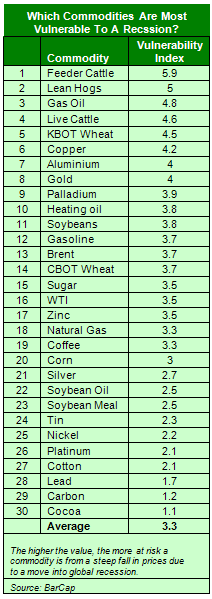A Barclays Capital research [report] notes that gold prices are vulnerable to a recession – more so than some of the other commodities. In the last recession of 2008, gold prices appreciated the least among precious metals. Below is a table that ranks 30 different commodities. Words: 571
So says an article* posted at www.zawya.com.
Lorimer Wilson, editor of www.munKNEE.com (Your Key to Making Money!), has further edited ([ ]), abridged (…) and reformatted the article below for the sake of clarity and brevity to ensure a fast and easy read. The author’s views and conclusions are unaltered and no personal comments have been included to maintain the integrity of the original article. Please note that this paragraph must be included in any article re-posting to avoid copyright infringement.
Who in the world is currently reading this article along with you? Click here
The article goes on to say, in part:
Gold’s Vulnerability
Of all commodities, gold is placed as the 8th [ see table below] most vulnerable in a recession, according to the BarCap study, which took into account inventory levels, correlation to emerging markets and their performance in the crisis of 2008.

Notes the BarCap research:
Gold’s fairly high ranking is interesting because it performed relatively well in 2008-09. However, this time around, gold prices have been stronger than they were prior to September 2008, whilst speculative positioning is also a little higher.
Gold’s strong performance in previous economic downturns is a positive, but not enough to offset these other negatives. It is important to note, however, that gold’s high ranking is also a function of fundamental factors such as costs and emerging market exposure, which are arguably less important in influencing gold prices than they are for other commodities.
Why spend time surfing the internet looking for informative and well-written articles on the health of the economies of the U.S., Canada and Europe; the development and implications of the world’s financial crisis and the various investment opportunities that present themselves related to commodities (gold and silver in particular) and the stock market when we do it for you. We assess hundreds of articles every day, identify the best and then post edited excerpts of them to provide you with a fast and easy read.
Sign up here to begin receiving munKNEE.com’s FREE Financial Intelligence Report
In addition, gold-supportive factors that are less important for other commodities, such as being a hedge of economic and financial uncertainty, have not been taken into account in the research [causing BarCap to express caution, as follows]:
Therefore, the implication of gold’s high ranking needs to be hedged somewhat. Nevertheless, it does suggest that if the financial factors that have supported physical investment buying were to fade, then gold prices could start to look very precarious indeed.
Crude Oil’s Vulnerability
The BarCap research ranks crude vulnerability at midlevel [Brent #13 and WTI (West Texas Intermediate) #16 out of 30 commodities], primarily due to low inventory levels, noting:
30 commodities], primarily due to low inventory levels, noting:
[The report also mentions that] crude prices have [also] benefited from disruptive supplies from Libya to Iraq, Yemen, Syria, North Sea crude and underperformance in oil production in Russia, China, Canada and Nigeria, saying:A relatively low level of inventories globally is supportive, but linkage to emerging markets is relatively low, whilst it has an above-average linkage to global growth and speculative interest is relatively high. Brent crude prices appear more vulnerable to a sharp slowdown in growth and oil demand than WTI, mainly because WTI oil prices have already fallen much further.
Crude oil spare capacity is very low. At an estimated 2-3m bpd, most of it held by Saudi Arabia and made up of more sour, heavy crude types, the global oil supply industry has very little slack in its system. This means that, as was the case in 2008, OPEC should have little difficulty in cutting output significantly if required. The combination of low inventories and limited spare capacity suggests a high degree of support for crude oil prices even if demand conditions deteriorate significantly.
*http://www.zawya.com/story.cfm/sidZAWYA20111006051717/Why_golds_vulnerable
Related Articles:
 munKNEE.com Your Key to Making Money
munKNEE.com Your Key to Making Money